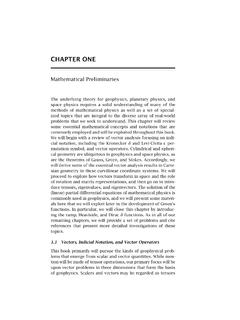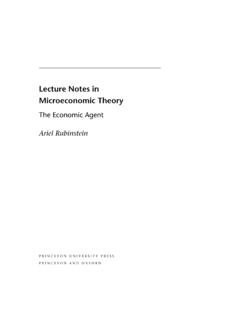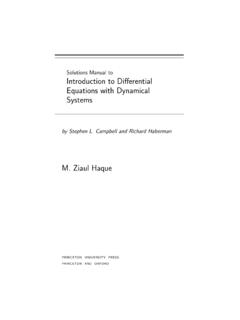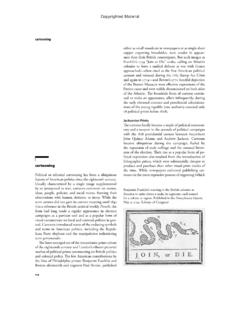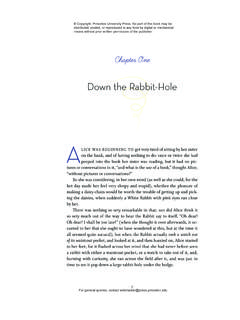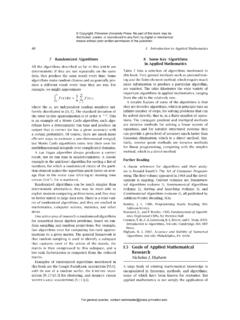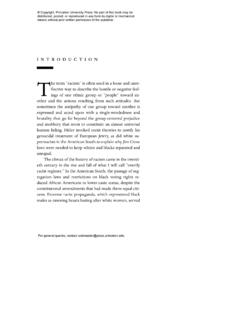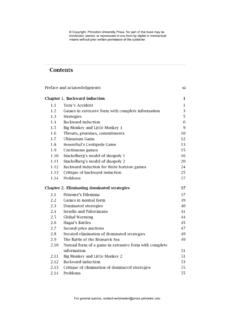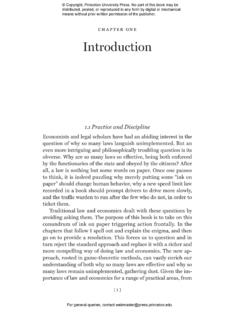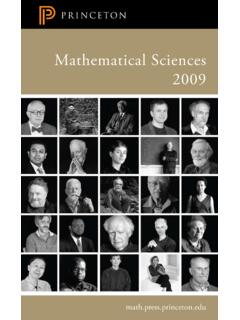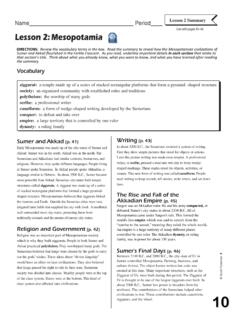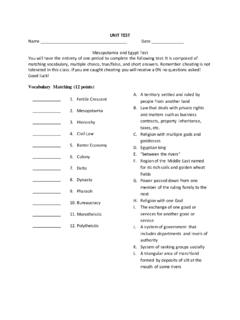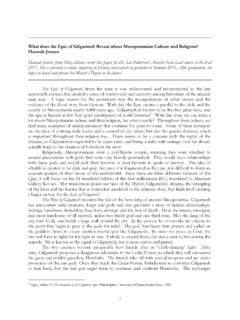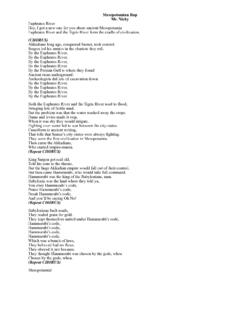Transcription of Mesopotamia, 1800 BCE - Princeton University
1 1 mesopotamia , 1800 BCEWe would more properly have to call Babylonian many things which the Greektradition had brought down to us as Pythagorean. Otto Neugebauer, quoted in Bartel van der Waerden, Science Awakening, p. 77 The vast region stretching from the Euphrates and Tigris Rivers in the east tothe mountains of Lebanon in the west is known as the Fertile Crescent. It washere, in modern Iraq, that one of the great civilizations of antiquity rose toprominence four thousand years ago: mesopotamia . Hundreds of thousands ofclay tablets, found over the past two centuries, attest to a people who flour-ished in commerce and architecture, kept accurate records of astronomicalevents, excelled in the arts and literature, and, under the rule of Hammurabi,created the first legal code in history. Only a small fraction of this vast archeo-logical treasure trove has been studied by scholars; the great majority of tabletslie in the basements of museums around the world, awaiting their turn to bedeciphered and give us a glimpse into the daily life of ancient the tablets that have received special scrutiny is one with the unas-suming designation YBC 7289, meaning that it is tablet number 7289 in theBabylonian Collection of Yale University (fig.)
2 The tablet dates from theOld Babylonian period of the Hammurabi dynasty, roughly 1800 1600 bce. Itshows a tilted square and its two diagonals, with some marks engraved alongone side and under the horizontal diagonal. The marks are in cuneiform(wedge-shaped) characters, carved with a stylus into a piece of soft clay whichwas then dried in the sun or baked in an oven. They turn out to be numbers,written in the peculiar Babylonian numeration system that used the base this sexagesimal system, numbers up to 59 were written in essentially ourmodern base-ten numeration system, but without a zero. Units were written asvertical Y-shaped notches, while tens were marked with similar notches writtenhorizontally. Let us denote these symbols by and , respectively. The number23, for example, would be written as . When a number exceeded 59, mesopotamia , 1800 bce 5 Figure YBC 7289it was arranged in groups of 60 in much the same way as we bunch numbersinto groups of ten in our base-ten system.
3 Thus, 2,413 in the sexagesimal systemis 40 60+13, which was written as (often a group ofseveral identical symbols was stacked, evidently to save space).Because the Babylonians did not have a symbol for the empty slot ourmodern zero there is often an ambiguity as to how the numbers should begrouped. In the example just given, the numerals couldalso stand for 40 602+13 60=144,780; or they could mean 40/60+13= , or any other combination of powers of 60 with the coefficients40and 13. Moreover, had the scribe made the space between and too small, the number might have erroneously been read as , that is, 50 60+3=3,003. In such cases the correct interpretationmust be deduced from the context, presenting an additional challenge to schol-ars trying to decipher these ancient , in the case of YBC 7289 the task was relatively easy. The numberalong the upper-left side is easily recognized as 30.
4 The one immediately un-der the horizontal diagonal is 1;24,51,10 (we are using here the modern nota-tion for writing Babylonian numbers, in which commas separate the sexagesi-mal digits, and a semicolon separates the integral part of a number from itsfractional part). Writing this number in our base-10 system, we get1+24/60+51/602+10/603= , which is none other than the decimalvalue of , accurate to the nearest one hundred thousandth! And when thisnumber is multiplied by 30, we get , which is the sexagesimal num-ber 42;25,35 the number on the second line below the diagonal. The conclu-sion is inescapable: the Babylonians knew the relation between the length of the diagonal of a square and its side, . But this in turn means that theywere familiar with the Pythagorean theorem or at the very least, with its spe-cial case for the diagonal of a square (d2=a2+a2=2a2) more than a thou-sand years before the great sage for whom it was things about this tablet are especially noteworthy.
5 First, it proves thatthe Babylonians knew how to compute the square root of a number to a re-markable accuracy in fact, an accuracy equal to that of a modern even more remarkable is the probable purpose of this particu-lar document: by all likelihood, it was intended as an example of how to findthe diagonal of anysquare: simply multiply the length of the side by1;24,51,10. Most people, when given this task, would follow the obvious but more tedious route: start with 30, square it, double the result, and take thesquare root: , rounded to four suppose you had to do this over and over for squares of different sizes;you would have to repeat the process each time with a new number, a rathertedious task. The anonymous scribe who carved these numbers into a claytablet nearly four thousand years ago showed us a simpler way: just multiplythe side of the square by (fig.)
6 Some simplification!2d=+= =3030180042 Chapter 1 But there remains one unanswered question: why did the scribe choose aside of 30 for his example? There are two possible explanations: either thistablet referred to some particular situation, perhaps a square field of side 30 forwhich it was required to find the length of the diagonal; or and this is moreplausible he chose 30 because it is one-half of 60 and therefore lends itself toeasy multiplication. In our base-ten system, multiplying a number by 5 canbe quickly done by halving the number and moving the decimal point oneplace to the right. For example, 5=( ) 10= 10= (more generally, ). Similarly, in the sexagesimal system multi-plying a number by 30 can be done by halving the number and moving the sexagesimal point one place to the right .Let us see how this works in the case of YBC 7289.
7 We recall that1;24,51,10 is short for 1+24/60+51/602+10/603. Dividing this by 2, we getwhich we must rewrite so that each coefficient of a power of 60 is an integer. To do so, we replace the 1/2 in the first and third terms byby 30/60, gettingFinally,moving the sexagesimal point one place to the right gives us 42;25,35, thelength of the diagonal. It thus seems that our scribe chose 30 simply for prag-matic reasons: it made his calculations that much easier. If YBC 7289 is a remarkable example of the Babylonians mastery of ele-mentary geometry, another clay tablet from the same period goes even further:it shows that they were familiar with algebraic procedures as as306012602560560426025603560306023230++ + = + + =+; 42, 25, ++ +,()aa = 30602aa = 5102 mesopotamia , 1800 bce 7aa a__ 2 Figure A square and its diagonalPlimpton 322 (so named because it is number 322 in the G. A. Plimpton Col-lection at Columbia University ; see fig.)
8 , it is a table of four columns,which might at first glance appear to be a record of some commercial transac-tion. A close scrutiny, however, has disclosed something entirely different: thetablet is a list of Pythagorean triples, positive integers (a, b, c) such thata2+b2=c2. Examples of such triples are (3, 4, 5), (5, 12, 13), and (8, 15, 17).Because of the Pythagorean theorem,3every such triple represents a right tri-angle with sides of integer , the left edge of the tablet is partially missing, but traces ofmodern glue found on the edges prove that the missing part broke off afterthe tablet was discovered, raising the hope that one day it may show up onthe antiquities market. Thanks to meticulous scholarly research, the missingpart has been partially reconstructed, and we can now read the tablet with rel-ative ease. Table reproduces the text in modern notation.
9 There are fourcolumns, of which the rightmost, headed by the words its name in the orig-inal text, merely gives the sequential number of the lines from 1 to 15. Thesecond and third columns (counting from right to left) are headed solvingnumber of the diagonal and solving number of the width, respectively;that is, they give the length of the diagonal and of the short side of a rectan-gle, or equivalently, the length of the hypotenuse and the short leg of a righttriangle. We will label these columns with the letters cand b, respectively. As8 Chapter 1 Figure Plimpton 322 mesopotamia , 1800 bce 9an example, the first line shows the entries b=1,59 and c=2,49, which rep-resent the numbers 1 60+59=119 and 2 60+49=169. A quick calcu-lation gives us the other side as hence(119, 120, 169) is a Pythagorean triple. Again, in the third line we readb=1,16,41=1 602+16 60+41=4601, and c=1,50,49=1 602+50 60+49=6649; therefore, giv-ing us the triple (4601, 4800, 6649).
10 The table contains some obvious errors. In line 9 we find b=9,1=9 60+1=541 and c=12, 49=12 60+49=769, and these do not forma Pythagorean triple (the third number anot being an integer). But if wereplace the 9,1 by 8,1=481, we do indeed get an integer value for a:resulting in the triple (481, 600, 769).It seems that this error was simply a typo ; the scribe may have been momen-tarily distracted and carved nine marks into the soft clay instead of eight; andonce the tablet dried in the sun, his oversight became part of recorded ==769481360 00060022,a= ==6649460123 040 000480022,a= = =1691191440012022;Table 322(c/a)2bc[1,59,0,]151,592,491[1,56,56, ]58,14,50,6,1556,73,12,12[1,55,7,]41,15, 33,451,16,411,50,493[1,]5[3,1]0,29,32,52 ,163,31,495,9,14[1,]48,54,1,401,51,375[1 ,]47,6,41,405,198,16[1,]43,11,56,28,26,4 038,1159,17[1,]41,33,59,3,4513,1920,498[ 1,]38,33,36,369,112,4991,35,10,2,28,27,2 4,26,401,22,412,16,1101,33,45451,15111,2 9,21,54,2,1527,5948,4912[1,]27,0,3,457,1 2,14,49131,25,48,51,35,6,4029,3153,4914[ 1,]23,13,46,40565315 Note: The numbers in brackets are , in line 13 we have b=7,12,1=7 602+12 60+1=25 921 and c=4,49=4 60+49=289, and these do not form a Pythagorean triple.
